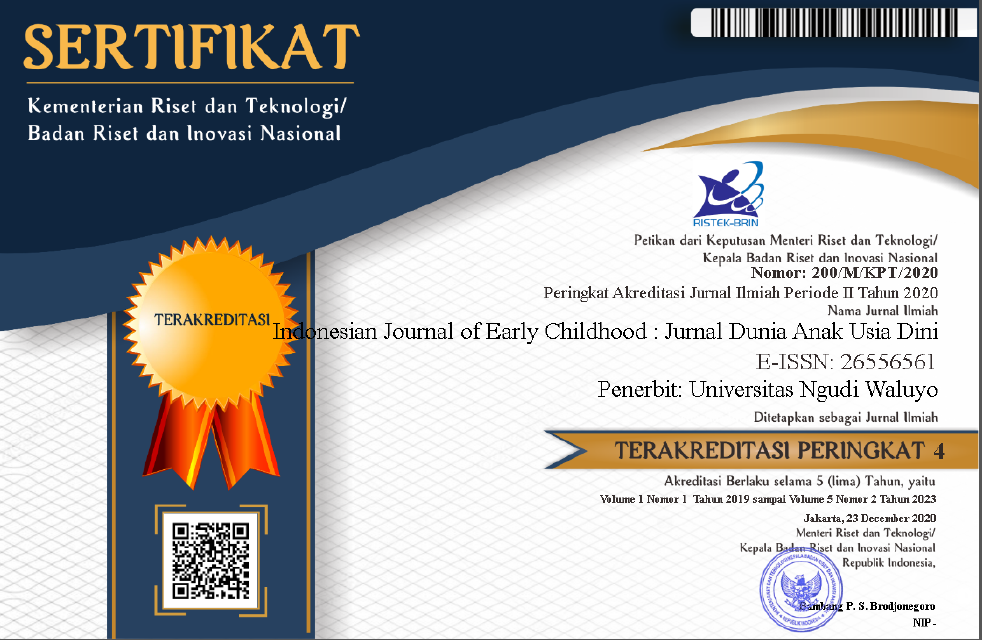Transformasi Pendidikan Anak Usia Dini melalui Media AI: Sebuah Pendekatan Inklusif
Transforming Early Childhood Education through AI Media: An Inclusive Approach
DOI:
https://doi.org/10.35473/ijec.v7i1.3615Keywords:
Media; Kecerdasan Buatan; Pendidikan; InklusifAbstract
This research aims to explore the potential of artificial intelligence (AI)-based media in transforming early childhood education (ECE) through an inclusive approach. Using a literature review-based qualitative method, this research analyzes the current literature related to the application of AI in ECD education. The results show that AI media can support personalized learning, improve children's cognitive, language, and social development, and create an inclusive learning environment. AI media also enables accessibility for children with special needs through adaptive features such as voice recognition and interactive visualizations. However, the implementation of these technologies requires support in the form of infrastructure, teacher training, and integrated education policies. The study concludes that AI has great potential to be an innovative solution in addressing ECD education challenges and recommends further research to evaluate its long-term impact.
ABSTRAK
Penelitian ini bertujuan untuk mengeksplorasipotensi media berbasiskecerdasanbuatan (AI) dalam mentransformasi pendidikan anak usia dini (PAUD) melalui pendekatan inklusif. Dengan menggunakan metode kualitatif berbasis telaah pustaka, penelitian ini menganalisis literature terkini terkait penerapan AI dalam pendidikan PAUD. Hasil studi menunjukkan bahwa media AI dapat mendukung pembelajaran personalisasi, meningkatkan perkembangan kognitif, bahasa, dan sosial anak, serta menciptakan lingkungan belajar yang inklusif. Media AI juga memungkinkan aksesibilitas bagi anak-anak dengan kebutuhan khusus melalui fitur adaptif seperti pengenalan suara dan visualisasi interaktif. Namun, implementasi teknologi ini memerlukan dukungan dalam bentuk infrastruktur, pelatihan guru, dan kebijakan pendidikan yang terintegrasi. Studi ini menyimpulkan bahwa AI memiliki potensi besar untuk menjadi solusi inovatif dalam mengatasi tantangan pendidikan PAUD dan merekomendasikan penelitian lebih lanjut untuk mengevaluasi dampak jangka panjangnya.
References
Arisanti, I., Kasim, M., &Mardikawati, B. (2024). Peran Aplikasi Artificial Intelligences AI Dalam Mengembangkan Dan MeningkatkanKompetensiProfesional Dan KreatifitasPendidik Di Era Cybernetics 4.0. INNOVATIVE: Journal Of Social Science Research, 4(1). https://j-innovative.org/index.php/Innovative
Ayanwale, M. A., Sanusi, I. T., Adelana, O. P., Aruleba, K. D., &Oyelere, S. S. (2022). Teachers’ readiness and intention to teach artificial intelligence in schools. Computers and Education: Artificial Intelligence, 3, 100099. https://doi.org/10.1016/j.caeai.2022.100099
Ayeni, O. O., Hamad, N. M. A., Chisom, O. N., Osawaru, B., & Adewusi, O. E. (2024). AI in education: A review of personalized learning and educational technology. GSC Advanced Research and Reviews, 18(2), 261–271. https://doi.org/10.30574/gscarr.2024.18.2.0062
Berson, I. R., & Berson, M. J. (2024). Fragments of the past: The intersection of AI, historical imagery, and early childhood creativity. Future in Educational Research, fer3.46. https://doi.org/10.1002/fer3.46
Bhutoria, A. (2022). Personalized education and Artificial Intelligence in the United States, China, and India: A systematic review using a Human-In-The-Loop model. Computers and Education: Artificial Intelligence, 3, 100068. https://doi.org/10.1016/j.caeai.2022.100068
candra, K. (2024). Pembelajaran masa Depan: Transformasi AI dan E-Learning di Era Pendidikan Digital. yayasanSahabat Alam Rafflesia.
Chen, X., Xie, H., Zou, D., & Hwang, G.-J. (2020). Application and theory gaps during the rise of Artificial Intelligence in Education. Computers and Education: Artificial Intelligence, 1, 100002. https://doi.org/10.1016/j.caeai.2020.100002
Durrani, R., Iqbal, A., & Akram, H. (2024). Artificial Intelligence (AI) in Early Childhood Education, Exploring Challenges, Opportunities and Future Directions: A Scoping Review. Qlantic Journal of Social Sciences, 5(2), 411–423. https://doi.org/10.55737/qjss.135537445
Fadiyah, D., & Akbar, Y. M. (2024). Artificial Intelligence Through Games for Early Childhood (Case Study: Kindergarten School). Madani JurnalPolitik Dan SosialKemasyarakatan, 16(01), 97–106. https://doi.org/10.52166/madani.v16i01.6481
Fatmawati, N. M. & Raharjo. (2024). Utilization of Artificial Intelligence-Based Learning Videos: Enhancing Learning Interest in Early Childhood Moral Education. Golden Age: JurnalIlmiahTumbuh Kembang Anak Usia Dini, 9(3), 475–486. https://doi.org/10.14421/jga.2024.93-09
Haoning Mah, G., Hu, X., & Yang, W. (2021). Digital technology use and early reading abilities among bilingual children in Singapore. Policy Futures in Education, 19(2), 242–258. https://doi.org/10.1177/1478210320980575
Herodotou, C. (2018). Young children and tablets: A systematic review of effects on learning and development. Journal of Computer Assisted Learning, 34(1), 1–9. https://doi.org/10.1111/jcal.12220
Kusumastuti, A., &Khoiron, A. M. (2019). Metode PenelitianKualitatif. Lembaga Pendidikan Sukarno Pressindo (LPSP).
Lesner, J., Murayama, L., Guizar, T., Phunjamaneechot, P., & Shapiro, D. (2024). A Demonstration of AI Personalized Interactive Fiction for Young Children. In Frontiers in Artificial Intelligence and Applications. IOS Press. https://doi.org/10.3233/FAIA241036
Liu, C., & Hwang, G.-J. (2023). Roles and research trends of touchscreen mobile devices in early childhood education: Review of journal publications from 2010 to 2019 based on the technology-enhanced learning model. Interactive Learning Environments, 31(3), 1683–1702. https://doi.org/10.1080/10494820.2020.1855210
Mantilla, A., & Edwards, S. (2019). Digital technology use by and with young children: A systematic review for the Statement on Young Children and Digital Technologies. Australasian Journal of Early Childhood, 44(2), 182–195. https://doi.org/10.1177/1836939119832744
Nurhasanah R, N. R., &Dwiyama, F. (2019). Pengembangan Lembaga Paud MelaluiImplementasiManajamenBerbasisSekolah. Adaara: JurnalManajemen Pendidikan Islam, 8(1), 797–815. https://doi.org/10.35673/ajmpi.v8i1.419
Ruslianti, Sabariah, Saqinah, F., & Susanti, D. (2023). PerkembanganOtak Anak Usia Dini Dan Dampaknya Pada KehidupanSeumur Hidup. Jurnal Tambora, 7(1).
Siringoringo, R. G., &Alfaridzi, M. Y. (2024). Pengaruh Integrasi TeknologiPembelajaranterhadapEfektivitas dan TransformasiParadigma Pendidikan Era Digital. JurnalYudistira :Publikasi Riset Ilmu Pendidikan dan Bahasa, 2(3), 66–76. https://doi.org/10.61132/yudistira.v2i3.854
Smith, J., Brown, E., Johnson, M., Williams, D., Aarav Deshmukh, & Rodriguez, S. (2024). Adaptive Learning Strategies for Online Education Among Adolescents. https://doi.org/10.13140/RG.2.2.20809.15209
Solichah, N., &Shofiah, N. (2024). Artificial Intelligence (AI) Literacy in Early Childhood Education: A Scoping Review. Psikologika: JurnalPemikiran Dan PenelitianPsikologi, 29(2). https://doi.org/10.20885/jstl.vol29.iss2.art1
Song, Y., Weisberg, L. R., Zhang, S., Tian, X., Boyer, K. E., & Israel, M. (2024). A framework for inclusive AI learning design for diverse learners. Computers and Education: Artificial Intelligence, 6, 100212. https://doi.org/10.1016/j.caeai.2024.100212
Su, J., Ng, D. T. K., & Chu, S. K. W. (2023). Artificial Intelligence (AI) Literacy in Early Childhood Education: The Challenges and Opportunities. Computers and Education: Artificial Intelligence, 4, 100124. https://doi.org/10.1016/j.caeai.2023.100124
Su, J., & Yang, W. (2022). Artificial intelligence in early childhood education: A scoping review. Computers and Education: Artificial Intelligence, 3, 100049. https://doi.org/10.1016/j.caeai.2022.100049
Su, J., & Zhong, Y. (2022). Artificial Intelligence (AI) in early childhood education: Curriculum design and future directions. Computers and Education: Artificial Intelligence, 3, 100072. https://doi.org/10.1016/j.caeai.2022.100072
Sulisworo, D., Fitrianawati, M., Subrata, A. C., Oktavianti, I. N., Prayogi, I., Maryani, I., Wulandari, Y., Fahmi, S., Priwantoro, S. W., Santosa, H., Erviana, V. Y., Pramudya, Y., Suardiman, S. P., Fatimah, N., Santosa, A. B., Hidayati, R. N., Widodo, P., Widyantoro, A., Yahya, M. S. T., … Purwanto, W. E. (2024). Transformasi Pendidikan Abad XXI; Sebuah Bunga Rampai. K-Media.
Sulkipani, Afnarius, S., Sudrajat, Santoso, I., Sri Nurhayati, Halim, L., Mutia, A. S., Argadinata, H., Jayanti, N. R., & Arromal, M. F. (2024). Teknologi Pendidikan. Eureka Media Aksara.
Sunarti, S. (2024). TransformasiPembelajaran Digital Dengan Artificial Intelligence. JurnalPerspektif, 17(1), 85–96. https://doi.org/10.53746/perspektif.v17i1.171
Suryani, A., Loliyana, Rohman, F., Sowiyah, Sugianto, &Khomsiyati, S. (2024). Artificial Intelligence sebagai Media Pembelajaranuntuk Anak Usia Dini. Jurnal Program Studi Pendidikan Anak Usia Dini, 13(3).
Thomas, C., Puneeth Sarma, K. A. V., Swaroop Gajula, S., &Jayagopi, D. B. (2022). Automatic prediction of presentation style and student engagement from videos. Computers and Education: Artificial Intelligence, 3, 100079. https://doi.org/10.1016/j.caeai.2022.100079
Xia, X. (2022). Diversion inference model of learning effectiveness supported by differential evolution strategy. Computers and Education: Artificial Intelligence, 3, 100071. https://doi.org/10.1016/j.caeai.2022.100071
Yang, W. (2022). Artificial Intelligence education for young children: Why, what, and how in curriculum design and implementation. Computers and Education: Artificial Intelligence, 3, 100061. https://doi.org/10.1016/j.caeai.2022.100061
Yuniarni, D. (2016). Peran Paud Dalam MengoptimalkanTumbuh Kembang Anak Usia Dini Demi Membangun Masa DepanBangsa. Jurnal Visi Ilmu Pendidikan, 8(1). https://doi.org/10.26418/jvip.v8i1.27370
Zed, M. (2014). Metode PenelitianKepustakaan. yayasanObor Indonesia.
Zulkarnaen, &Handoyo, A. D. (2019). Faktor-faktorPenyebab Pendidikan Tidak Merata di Indonesi. Prosiding Seminar Nasional. MenjadiMahasiswa yang Unggul di Era Industri 4.0 dan Society 5.0, Yogyakarta.
Downloads
Published
How to Cite
Issue
Section
License
Copyright (c) 2025 Indonesian Journal of Early Childhood: Jurnal Dunia Anak Usia Dini

This work is licensed under a Creative Commons Attribution-ShareAlike 4.0 International License.
Please find the rights and licenses in Indonesian Journal Of Early Childhood: Jurnal Dunia Anak Usia DIni. By submitting the article/manuscript of the article, the author(s) agree with this policy. No specific document sign-off is required.
1. License
The non-commercial use of the article will be governed by the Creative Commons Attribution license as currently displayed on Creative Commons Attribution-ShareAlike 4.0 International License.
2. Author(s)' Warranties
The author warrants that the article is original, written by stated author(s), has not been published before, contains no unlawful statements, does not infringe the rights of others, is subject to copyright that is vested exclusively in the author and free of any third party rights, and that any necessary written permissions to quote from other sources have been obtained by the author(s).
3. User Rights
Indonesian Journal Of Early Childhood: Jurnal Dunia Anak Usia Dini's spirit is to disseminate articles published are as free as possible. Under the Creative Commons license, Indonesian Journal Of Early Childhood: Jurnal Dunia Anak Usia Dini permits users to copy, distribute, display, and perform the work for non-commercial purposes only. Users will also need to attribute authors and Indonesian Journal Of Early Childhood: Jurnal Dunia Anak Usia Dini on distributing works in the journal and other media of publications.
4. Co-Authorship
If the article was jointly prepared by more than one author, any authors submitting the manuscript warrants that he/she has been authorized by all co-authors to be agreed on this copyright and license notice (agreement) on their behalf, and agrees to inform his/her co-authors of the terms of this policy. Indonesian Journal Of Early Childhood: Jurnal Dunia Anak Usia Dini will not be held liable for anything that may arise due to the author(s) internal dispute. Indonesian Journal Of Early Childhood: Jurnal Dunia Anak Usia Dini will only communicate with the corresponding author.
5. Miscellaneous
Indonesian Journal Of Early Childhood: Jurnal Dunia Anak Usia Dini will publish the article (or have it published) in the journal if the article’s editorial process is successfully completed. Indonesian Journal Of Early Childhood: Jurnal Dunia Anak Usia Dini's editors may modify the article to a style of punctuation, spelling, capitalization, referencing and usage that deems appropriate. The author acknowledges that the article may be published so that it will be publicly accessible and such access will be free of charge for the readers as mentioned in point 3.
Â
Every accepted manuscript should be accompanied by "Copyright Transfer Agreement" prior to the article publication.



